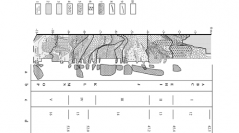

 Comptes Rendus Palevol
16 (1) - Pages 103-121
Comptes Rendus Palevol
16 (1) - Pages 103-121We evaluated the skeletal profiles from several levels of the Neanderthal site of Abric Romaní, focusing on the methodology proposed by Faith and Gordon (2007): differences in the skeletal distribution of animals in accordance with their size and weight; the statistical correlation between the skeletal profiles and standard food utility index; and the anatomical diversity of size-weight categories. Results indicate an unconstrained transport strategy in all levels and all size-weight categories. However, we also found differences in the skeletal distribution of medium-sized and large animals, which may be due to different transport strategies. These characteristics suggest that the superposition of transport and occupation events could be responsible for our results. In addition, we applied the same analysis to Hadza assemblages, which revealed similar results to those found at Abric Romaní. The most striking feature of the Hadza assemblages examined is the superposition of transport events as a result of successive occupation/deposition events. This suggests that the transport strategies used by Neanderthals at Abric Romaní are also characterized by a high degree of diversity in transport decisions.
Neanderthal, Food resources, Anatomical profiles, Unconstrained transport strategy